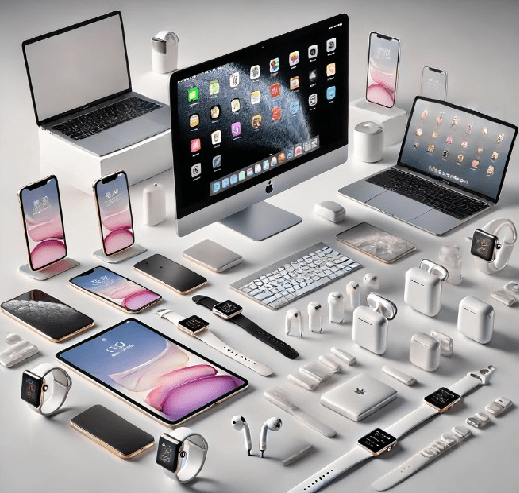Following Apple’s 5-day Worldwide Developers Conference (WWDC24) last week at Apple Park in Cupertino, California, we take a look at the many new products announced and their key features.

Showcasing New Products
At Apple’s WWDC24 from June 10 to June 14, Apple showcased a variety of updates and advancements across its software platforms, including iOS, iPadOS, macOS, watchOS, tvOS, and visionOS. Key announcements included significant updates for iOS 18 and macOS 15, as well as new AI integrations and improvements to built-in apps like Photos and Apple Music. Crucially, the conference also highlighted Apple’s commitment to AI technologies and its plans to integrate generative AI capabilities into its devices.
Let’s take a look at the key product and other announcements from WWDC24:
iOS 18
iOS 18, Apple’s latest iOS for iPhones introduces several significant updates, including a more customisable home screen, a redesigned Photos app with AI-powered editing tools, RCS support in Messages for improved cross-platform communication, and enhancements to the Mail, Calendar, and Maps apps. All these improvements are around making the iPhone more intuitive and powerful for users. Also, the Control Centre has now been revamped to feature a multipage layout with third-party widgets.
One other fun new feature for iOS 18 around user-personalisation will be the ability for iPhone users to make their conversations more enjoyable by creating AI images of people they’re messaging with in a way that’s similar to an AI-upgraded Bitmoji.
iPhones To Use Satellites
There was also the announcement at WWDC 24 that with iOS 18, iPhone users will be able to send messages via satellite. This feature, available on iPhone 14 models and later, expands upon the existing Emergency SOS via satellite capability. It allows users to send and receive iMessages and SMS texts, including emoji and Tapbacks, even when they are out of range of cellular and Wi-Fi networks.
macOS Sequoia
Apple’s macOS Sequoia, the latest version of its OS for Macs has been given a range of new features including a new Passwords app, redesigned Reader view in Safari with machine learning integration, upgrades to Messages and Notes, and improved window management. The update also includes enhancements to Continuity, such as iPhone Mirroring. With iPhone Mirroring, (through macOS’ Continuity feature), users can mirror their iPhone’s screen and control it from their Mac laptop or desktop.
All this should mean enhanced user productivity and convenience (better password management), a smarter browsing experience, more efficient multitasking, and improved messaging and note-taking capabilities.
iPadOS 18
iPadOS 18 brings updates to the Notes app, including support for Math Notes and a new Calculator app that supports Apple Pencil. It also introduces a floating tab bar for better navigation and similar home screen customisation options to iOS 18.
watchOS 11
watchOS 11, the latest version of Apple’s operating system for Apple Watch, adds a redesigned Photos face, a new Translate app, and enhancements to the Fitness app, including a Training Load feature and a customisable Summary mode. It also introduces the Vitals app for health monitoring. The hope is that these new features will provide users with a more personalised and comprehensive fitness and health tracking experience, and a more intuitive and visually engaging interface.
tvOS 18
tvOS 18, the latest version of Apple’s OS for Apple TV includes AI-enhanced subtitles, Amazon X-Ray-style information while watching, and clearer dialogue options, improving the viewing experience on Apple TV 4K.
‘InSight’ For Apple TV+
Those who use Apple TV+ may be pleased with the new InSight feature that displays actors’ names and song titles as they appear on the screen and is similar to Amazon’s X-Ray technology. Also, like Shazam, it highlights the song playing in the TV show or film and, as you may expect, then gives the user the option to add it to their Apple Music playlist.
visionOS 2
Apple’s OS for the Vision Pro headset, visionOS 2, has received upgrades to enhance the Vision Pro experience with new developer frameworks, an international launch schedule, and improved virtual display features. It also introduces new gestures and SharePlay support in the Photos app. For example, it will allow photos to be transformed into interactive experiences using AI. Notably, users will be able to turn existing images into spatial photos (including photos captured on older devices).
New navigation gestures are also being introduced, and it supports higher resolution and larger virtual displays for connected Macs.
Improvements also include new developer tools like volumetric APIs and TabletopKit for games, adds train support in travel mode, and expands content with new 180-degree 8K video formats through partnerships with content creators.
New Markets For Vision Pro Headsets Announced
Accompanying the news of the upgraded features in visionOS 2, Apple has also announced that it will be making its Vision Pro headset available in eight new countries – China, Japan, Singapore, Australia, Canada, France, Germany and the UK, and that the first release of the headset will be in China, Japan, and Singapore on June 28.
Apple Intelligence
The most significant announcement from WWDC24 is the introduction of Apple Intelligence, a new AI initiative aimed at integrating personal and private AI capabilities across Apple’s ecosystem. There was some concern that Apple has fallen behind in AI and its announcement that it is partnering with OpenAI to include its technology and ChatGPT, which prompted an angry reaction on X by Elon Musk (citing privacy concerns – although possibly more about competition concerns) is a significant strategic shift for Apple.
Apple Intelligence includes, for example, significant upgrades to Siri (as outlined below), making interactions more natural and advanced, and other functionalities with advanced, personal, and private AI capabilities. Apple CEO, Tim Cook, described Apple Intelligence as “the next frontier” in personal AI and explained that the reason why it is so effective is that it will be able to “understand you and be grounded in your personal context, like your routine, your relationships, your communications and more”.
Siri Upgrade
The new Apple Intelligence AI initiative has meant that Siri, Apple’s virtual assistant, has received a substantial upgrade. The AI enhancements make Siri more conversational and contextually aware, so it can handle more complex tasks and understand a wider variety of requests. This should include being able to summarise incoming messages, executing commands across multiple apps, and integrating more naturally with users’ daily activities. Apple has also emphasised how most processing will be done ‘on-device’ to help user privacy.
One significant announcement is, of course, that Siri will also be one of the apps that will be able to use OpenAI’s ChatGPT for “expertise”. Tapping into ChatGPT will also mean that users will also be able to include photos with questions for ChatGPT (via Siri) and even ask questions related to docs or PDFs.
Developers And Siri
It’s also worth noting here that Siri’s new capabilities will also allow developers to enable voice command access to any app menu items and displayed text without additional coding. This means users can issue commands like “show my presenter notes” in a slide deck or “FaceTime him” from a reminder, enhancing app functionality through natural language interactions and improving user experience.
Next-Generation CarPlay
Apple provided an updated look at the next-generation CarPlay system, the in-car system that allows users to integrate their iPhone with their vehicle’s infotainment system. The improvements include new Vehicle, Media, and Climate apps, designed to offer a more integrated and enhanced user experience.
What Does This Mean For Your Business?
The WWDC24 announcements appear to signify a transformative phase for Apple, with their belated yet determined and substantial adoption of AI all the way through their entire estate standing out as a strategic pivot. This initiative, which includes a partnership with OpenAI’s ChatGPT, enhances Siri’s capabilities, making it more contextually aware and conversational. For business users, this means more efficient and natural interactions with their devices, potentially improving productivity and streamlining workflows.
The upgrades across iOS, macOS, iPadOS, watchOS, and tvOS collectively may create a more cohesive and powerful Apple ecosystem. For instance, iOS 18’s customisation options and AI-powered tools should make iPhones more versatile and user-friendly, while macOS Sequoia’s new features may enhance productivity through smarter password management, improved multitasking, and seamless integration with iPhones. These improvements could help businesses better manage their digital environments, ensuring that employees can work more efficiently and securely.
The introduction of Messages via satellite with iOS 18 is significant for businesses operating in remote areas or in sectors where connectivity is often an issue, such as logistics, construction, and outdoor events, i.e. ensuring continuous communication, which is crucial for operational efficiency and safety.
Apple’s Vision Pro headset and the enhanced visionOS 2 signals a move towards more immersive and interactive experiences. For industries such as design, training, and presentations, the ability to turn photos into interactive experiences and use spatial navigation may offer new ways to engage and educate. The expanded international availability of the Vision Pro headset may also open up new markets and opportunities for businesses worldwide.
The updates to watchOS 11, with enhanced fitness and health tracking capabilities, emphasises Apple’s commitment to health and wellness, which may be particularly beneficial for businesses focusing on employee well-being and productivity. The new features in tvOS 18, such as AI-enhanced subtitles and detailed information while watching, enhance the user experience for both personal and professional usage, perhaps making Apple TV a more compelling option, e.g. for business presentations and entertainment.
Overall, Apple’s latest announcements reflect a strategic effort to integrate advanced AI and machine learning technologies across its product range. This not only addresses fears of Apple lagging behind in AI but this could even position Apple as a leader in the AI space. It also offers business users innovative tools to enhance productivity, connectivity, and user-engagement. By leveraging the advancements outlined by Apple at WWDC24, businesses could improve their operational efficiency, employee satisfaction, and customer interactions, which may ultimately give Apple a stronger foothold in the competitive tech marketplace.
By Mike Knight
